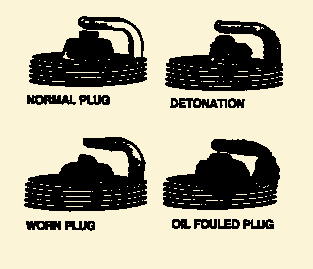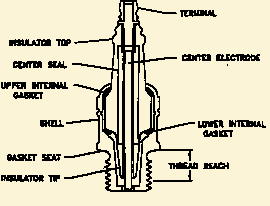About Spark Plugs
Dear Dr. Motorhead,
Can a spark plug go bad? Also, do these new high tech “splitfire” and “rimfire” spark plugs really work? Thank you, I’ll hang up and listen.
Signed, Sparky.
Dear Sparky,
Love your name. Used to have a dog by that name. A real smart dog
loved boating.You don’t like your ears scratched by any chance, do you?
Yes, spark plugs do go bad. But not as fast as many people think – and probably not fast enough for the manufacturers and auto parts retailers. Let’s step back to boating mechanics 101. What does the spark plug do? It draws energy from the coil as a ground. Because there is a gap between the electrode, the inner part, and the small tab or grounding electrode, there is an electrical charge, or spark produced. This is quite a large spark due to the 20,000 to 40,000 volts produced by your coil. Remember, electricity is not pushed, it is pulled by whatever type of resistance or ground at the end of the wire – whether a light bulb or a spark plug. This simple but effective contraption is made of metal and porcelain. The metal base is the ground that screws to the engine. The electrode is encased in porcelain. The porcelain is an insulator, like those used on an electric fence. This electrode allows the spark to occur only where it is supposed to, at the gap inside your engine.
A day in the life of a spark plug – or – if only they could talk, the stories these plugs could tell. Well, spark plugs can’t really talk, but they can tell you a lot about the health of your engine. See figure showing normal plug.
Sorry for rambling, it seems I take after my mentor. I’ll get to your question. Eventually anything and everything can wear out and need replacement, and occasionally even break. In all the years Dr. Motorhead has been messing with motors, he has had only one spark plug actually go bad and stop working. And believe me, he has a lot of cylinders to contend with. Many – far too many – plugs get thrown out needlessly. People tune up their engines and automatically replace the plugs. Clean, re-gap and replace is my motto.
If you use your boat 50 hours in a year, which is quite a lot, this would be equivalent to 1,500 miles in your car. Spark plugs are designed to last at least 10,000 miles with standard ignitions. Electronic ignitions will triple the life expectancies. Conceivably, a set should last you 6 to 18 years, depending on how many hours you use your boat. Plugs in aircraft engines are used for years and years. Every year, or 100 hours, whichever comes first, the airplane mechanic performs an inspection, removes the plugs, cleans, re-gaps them and reinstalls. They last for years.
 Here is what you have to do. Remove the plugs and check for one of the conditions shown above. If everything seems OK, clean them up. Auto garages have a small sandblasting devise that does a great job. If you don’t have one, (and why should you?) proceed with the following: First, wipe the tip with a rag, Then, with a small soft wire brush, gently scrub it down to clean all the electrodes. Finally, set the gap at .026 with your feeler gauge. That’s it! Reinstall and enjoy environmentally-sound boating.
Here is what you have to do. Remove the plugs and check for one of the conditions shown above. If everything seems OK, clean them up. Auto garages have a small sandblasting devise that does a great job. If you don’t have one, (and why should you?) proceed with the following: First, wipe the tip with a rag, Then, with a small soft wire brush, gently scrub it down to clean all the electrodes. Finally, set the gap at .026 with your feeler gauge. That’s it! Reinstall and enjoy environmentally-sound boating.
What about these new high tech “splitfire” and “rimfire” types you ask? To begin with, they aren’t that new. The rimfire-type have been used in aircraft engines for years. The splitfire was introduced also many years ago. Do they work? Yes, I am sure they help. Do they have the Dr. Motorhead seal of approval? Not really, but they can’t hurt either. So it is up to you. If I had to make a choice, I would use the rimfire type Here is some additional free advice. Most often our boats will all use either a J8 or J6 plug. The J is the physical size of the spark plug, the 8 is the heat rating. The higher the number, the hotter the plug. The spark plug heat range is the ability of the plug to dissipate heat. The longer the insulator (or the longer it extends into the engine), the hotter the plug will operate: the shorter the insulator the cooler it will operate. A plug that absorbs little heat and remains too cool will quickly accumulate deposits of oil and carbon since it is not hot enough to burn them off.  This leads to plug fouling and consequently, to misfiring. A plug that absorbs too much heat will have deposits also, but due to excessive heat, the electrodes will burn away quickly and in some instances, pre-ignition may result. The general rule of thumb is to use a hotter plug if you drive at slower speeds. The plug I use is the J8, as I drive my boat more often at slower speeds. If you drive your boat at faster speeds, use the J6, however, either one will work. In addition to the J8, you might run across a RJ8 or RJ8C. These are all basically the same. The “R” stands for resistance. So your radio, if you have one, won’t produce static noises in the speakers. The “C” identifies a copper core to the electrode – supposedly, better performance. Any one or all of them will work.
This leads to plug fouling and consequently, to misfiring. A plug that absorbs too much heat will have deposits also, but due to excessive heat, the electrodes will burn away quickly and in some instances, pre-ignition may result. The general rule of thumb is to use a hotter plug if you drive at slower speeds. The plug I use is the J8, as I drive my boat more often at slower speeds. If you drive your boat at faster speeds, use the J6, however, either one will work. In addition to the J8, you might run across a RJ8 or RJ8C. These are all basically the same. The “R” stands for resistance. So your radio, if you have one, won’t produce static noises in the speakers. The “C” identifies a copper core to the electrode – supposedly, better performance. Any one or all of them will work.
I’ll hang up and listen? Sounds like you have been talking to Click and Clack, the yak, yak guys. Next time you have a chance to speak with them, please tell them to take a pill. I wish I could find so much humor in my own stupid jokes. Any way …
In good stead,
Piston
PS: I’m filling in for the good Doctor this month, as he is on vacation. He mentioned to me that he’ll be back in the office in a fortnight, whatever that means.

